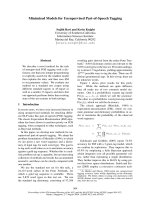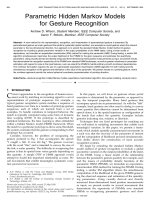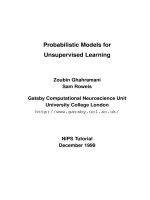probabilistic models for unsupervised learning
Bạn đang xem bản rút gọn của tài liệu. Xem và tải ngay bản đầy đủ của tài liệu tại đây (1.26 MB, 63 trang )
Probabilistic Models for
Unsupervised Learning
Zoubin Ghahramani
Sam Roweis
Gatsby Computational Neuroscience Unit
University College London
/>NIPS Tutorial
December 1999
Learning
Imagine a machine or organism that experiences over its
lifetime a series of sensory inputs:
Supervised learning: The machine is also given desired
outputs , and its goal is to learn to produce the
correct output given a new input.
Unsupervised learning: The goal of the machine is to
build representations from that can be used for
reasoning, decision making, predicting things,
communicating etc.
Reinforcement learning: The machine can also
produce actions which affect the state of the
world, and receives rewards (or punishments) .
Its goal is to learn to act in a way that maximises rewards
in the long term.
r
a
Goals of Unsupervised Learning
To find useful representations of the data, for example:
finding clusters, e.g. k-means, ART
dimensionality reduction, e.g. PCA, Hebbian
learning, multidimensional scaling (MDS)
building topographic maps, e.g. elastic networks,
Kohonen maps
finding the hidden causes or sources of the data
modeling the data density
We can quantify what we mean by “useful” later.
Uses of Unsupervised Learning
data compression
outlier detection
classification
make other learning tasks easier
a theory of human learning and perception
Probabilistic Models
A probabilistic model of sensory inputs can:
– make optimal decisions under a given loss
function
– make inferences about missing inputs
– generate predictions/fantasies/imagery
– communicate the data in an efficient way
Probabilistic modeling is equivalent to other views of
learning:
– information theoretic:
finding compact representations of the data
– physical analogies: minimising free energy of a
corresponding statistical mechanical system
Bayes rule
— data set
— models (or parameters)
The probability of a model given data set is:
is the evidence (or likelihood )
is the prior probability of
is the posterior probability of
Under very weak and reasonable assumptions, Bayes
rule is the only rational and consistent way to manipulate
uncertainties/beliefs (P
´
olya, Cox axioms, etc).
Bayes, MAP and ML
Bayesian Learning:
Assumes a prior over the model parameters.Computes
the posterior distribution of the parameters: .
Maximum a Posteriori
(MAP) Learning:
Assumes a prior over the model parameters .
Finds a parameter setting that
maximises the posterior: .
Maximum Likelihood
(ML) Learning:
Does not assume a prior over the model parameters.
Finds a parameter setting that
maximises the likelihood of the data: .
Modeling Correlations
Y
Y
1
2
Consider a set of variables .
A very simple model:
means
and
correlations
This corresponds to fitting a Gaussian to the data
There are parameters in this model
What if is large?
Factor Analysis
Y
D
Y
1
Y
2
X
1
K
X
Λ
Linear generative model:
are independent Gaussian factors
are independent Gaussian noise
So, is Gaussian with:
where is a matrix, and is diagonal.
Dimensionality Reduction: Finds a low-dimensional
projection of high dimensional data that captures most of
the correlation structure of the data.
Factor Analysis: Notes
Y
D
Y
1
Y
2
X
1
K
X
Λ
ML learning finds and given data
parameters (with correction from symmetries):
no closed form solution for ML params
Bayesian treatment would integrate over all and
and would find posterior on number of factors;
however it is intractable.
Network Interpretations
Y
D
Y
1
Y
2
X
1
K
X
Y
D
Y
1
Y
2
^
^
^
hidden
units
output
units
input
units
encoder
"recognition"
decoder
"generation"
autoencoder neural network
if trained to minimise MSE, then we get PCA
if MSE + output noise, we get PPCA
if MSE + output noises + reg. penalty, we get FA
Graphical Models
A directed acyclic graph (DAG) in which each node
corresponds to a random variable.
x5
x3
x1
x2
x4
Definitions: children, parents, descendents, ancestors
Key quantity: joint probability distribution over nodes.
(1) The graph specifies a factorization of this joint pdf:
pa( )
(2) Each node stores a conditional distribution over its
own value given the values of its parents.
(1) & (2) completely specify the joint pdf numerically.
Semantics: Given its parents, each node is
conditionally independent from its non-descendents
(Also known as Bayesian Networks, Belief Networks,
Probabilistic Independence Networks.)
Two Unknown Quantities
In general, two quantities in the graph may be unknown:
parameter values in the distributions pa( )
hidden (unobserved) variables not present in the data
Assume you knew one of these:
Known hidden variables, unknown parameters
this is complete data learning (decoupled
problems)
θ
=
?
θ
=
?
θ
=
?
θ
=
?
θ
=
?
Known parameters, unknown hidden variables
this is called inference (often the crux)
?
?
?
?
But what if both were unknown simultaneously
Learning with Hidden Variables:
The EM Algorithm
X
1
θ
1
θ
3
θ
2
θ
4
X
2
X
3
Y
Assume a model parameterised by with observable
variables and hidden variables
Goal: maximise log likelihood of observables.
E-step: first infer , then
M-step: find using complete data learning
The E-step requires solving the inference problem:
finding explanations, , for the data,
given the current model .
EM algorithm & -function
X
1
θ
1
θ
3
θ
2
θ
4
X
2
X
3
Y
Any distribution
over the hidden variables defines a
lower bound on called :
E-step: Maximise w.r.t. with fixed
M-step: Maximise w.r.t. with fixed
NB: max of is max of
Two Intuitions about EM
I. EM decouples the parameters
X
1
θ
1
θ
3
θ
2
θ
4
X
2
X
3
Y
The E-step “fills in” values for the hidden vari-
ables. With no hidden variables, the likeli-
hood is a simpler function of the parameters.
The M-step for the parameters at each n-
ode can be computed independently, and de-
pends only on the values of the variables at
that node and its parents.
II. EM is coordinate ascent in
EM for Factor Analysis
Y
D
Y
1
Y
2
X
1
K
X
Λ
E-step: Maximise w.r.t. with fixed
M-step: Maximise w.r.t. with fixed:
The E-step reduces to computing the Gaussian
posterior distribution over the hidden variables.
The M-step reduces to solving a weighted linear
regression problem.
Inference in Graphical Models
W
X Y
Z
Singly connected nets
The belief propagation
algorithm.
W
X Y
Z
Multiply connected nets
The junction tree algorithm.
These are efficient ways of applying Bayes rule using the
conditional independence relationships implied by the
graphical model.
How Factor Analysis is
Related to Other Models
Principal Components Analysis (PCA): Assume
no noise on the observations:
Independent Components Analysis (ICA): Assume
the factors are non-Gaussian (and no noise).
Mixture of Gaussians: A single discrete-valued
factor: and for all .
Mixture of Factor Analysers: Assume the data has
several clusters, each of which is modeled by a
single factor analyser.
Linear Dynamical Systems: Time series model in
which the factor at time depends linearly on the
factor at time , with Gaussian noise.
A Generative Model for Generative Models
Gaussian
Factor Analysis
(PCA)
Mixture of
Factor Analyzers
Mixture of
G
aussians
(VQ)
Cooperative
Vector
Quantization
S
BN,
Boltzmann
Machines
Factorial HMM
HMM
Mixture of
HMMs
Switching
State-space
Models
ICA
Linear
Dynamical
S
ystems (SSMs)
Mixture of
LDSs
Nonlinear
Dynamical
Systems
Nonlinear
Gaussian
Belief Nets
mix
mix
mix
switch
red-dim
red-dim
dyn
dyn
dyn
dyn
dyn
mix
distrib
hier
nonlin
hier
nonlin
distrib
mix : mixture
red-dim : reduced
dimension
dyn : dynamics
distrib : distributed
representation
hier : hierarchical
nonlin : nonlinear
switch : switching
Mixture of Gaussians and K-Means
Goal: finding clusters in data.
To generate data from this model, assuming clusters:
Pick cluster with probability
Generate data according to a Gaussian with
mean and covariance
E-step: Compute responsibilities for each data vec.
M-step: Estimate , and using data weighted by
the responsibilities.
The k-means algorithm for clustering is a special case of
EM for mixture of Gaussians where
Mixture of Factor Analysers
Assumes the model has several clusters
(indexed by a discrete hidden variable
).
Each cluster is modeled by a factor analyser:
where
it’s a way of fitting a mixture of Gaussians
to high-dimensional data
clustering and dimensionality reduction
Bayesian learning can infer a posterior over the
number of clusters and their intrinsic
dimensionalities.
Independent Components Analysis
Y
D
Y
1
Y
2
X
1
K
X
Λ
is non-Gaussian.
Equivalently is Gaussian and
where is a nonlinearity.
For , and observation noise assumed to be
zero, inference and learning are easy (standard ICA).
Many extensions possible (e.g. with noise IFA).
Hidden Markov Models/Linear Dynamical Systems
PSfrag replacements
Hidden states , outputs
Joint probability factorises:
you can think of this as:
Markov chain with stochastic measurements.
Gauss-Markov process in a pancake.
PSfrag replacements
or
Mixture model with states coupled across time.
Factor analysis through time.
PSfrag replacements
HMM Generative Model
PSfrag replacements
plain-vanilla HMM
“probabilistic function of a Markov chain”:
1. Use a 1st-order Markov chain to generate a
hidden state sequence (path):
2. Use a set of output prob. distributions (one
per state) to convert this state path into a
sequence of observable symbols or vectors
Notes:
– Even though hidden state seq. is 1st-order Markov, the
output process is not Markov of any order
[ex. 1111121111311121111131 ]
– Discrete state, discrete output models can approximate any
continuous dynamics and observation mapping even if
nonlinear; however lose ability to interpolate









